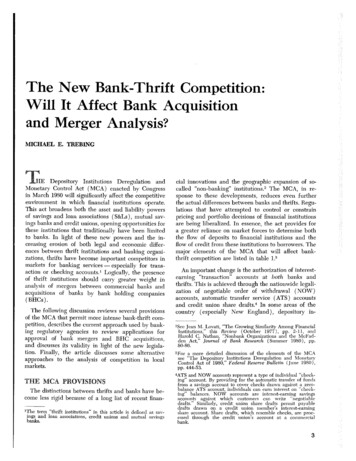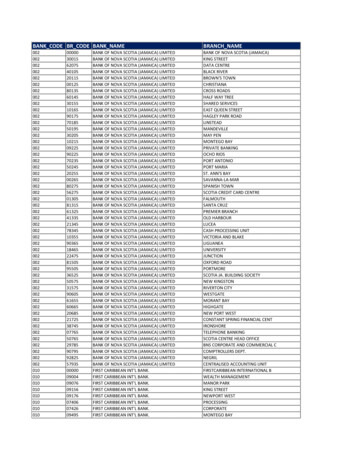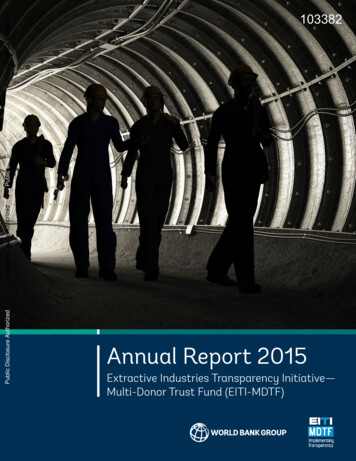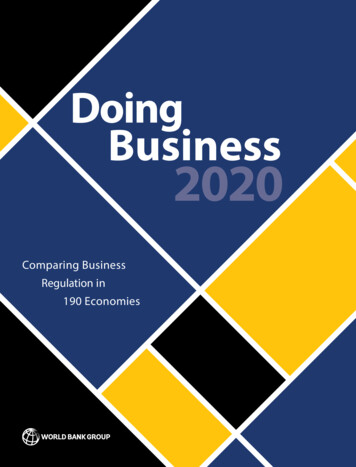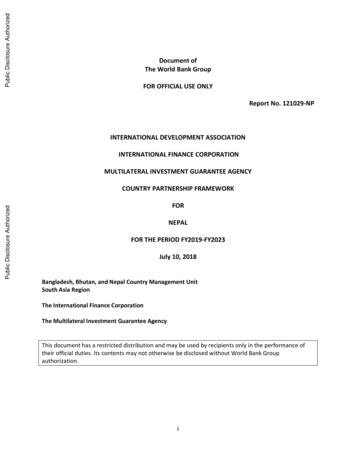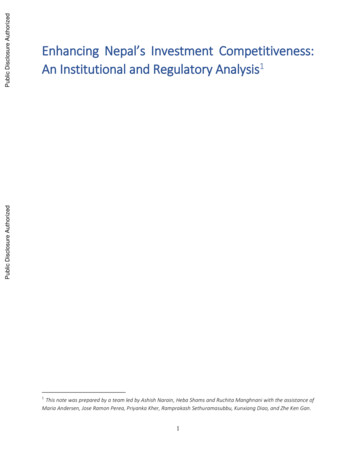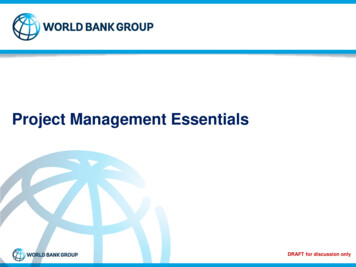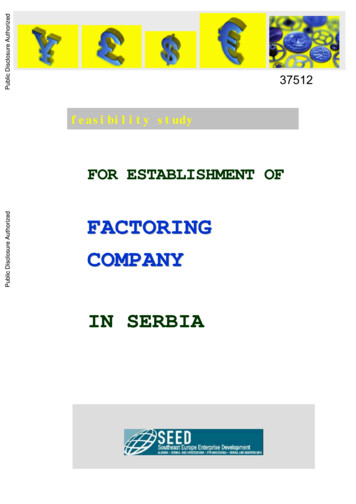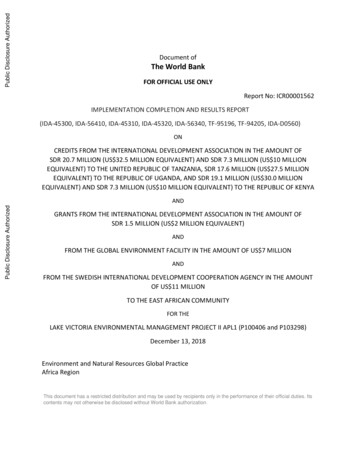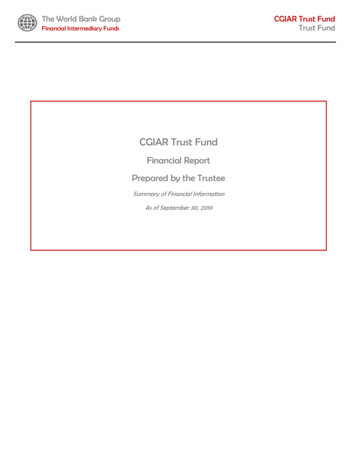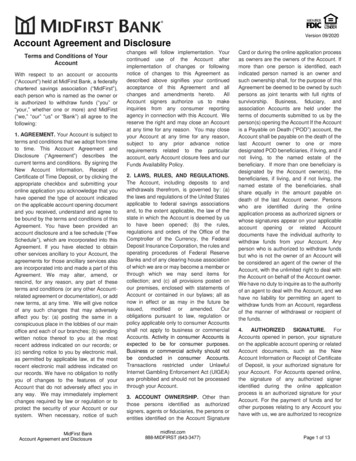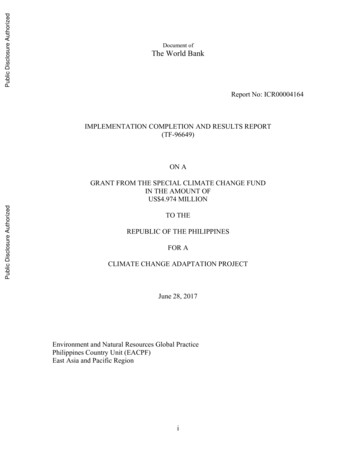
Transcription
Public Disclosure AuthorizedDocument ofThe World BankPublic Disclosure AuthorizedPublic Disclosure AuthorizedReport No: ICR00004164IMPLEMENTATION COMPLETION AND RESULTS REPORT(TF-96649)ON AGRANT FROM THE SPECIAL CLIMATE CHANGE FUNDIN THE AMOUNT OFUS 4.974 MILLIONTO THEREPUBLIC OF THE PHILIPPINESFOR ACLIMATE CHANGE ADAPTATION PROJECTPublic Disclosure AuthorizedJune 28, 2017Environment and Natural Resources Global PracticePhilippines Country Unit (EACPF)East Asia and Pacific Regioni
CURRENCY EQUIVALENTS(Exchange Rate Effective December 31, 2016Currency Unit Philippines pesosPHP 1.00 US 0.02US 1.00 PHP 49.50January 1- December 31ABBREVIATIONS AND FSEIRRENRMENSOFASPSGDPGEFGEOGIUGIZHLURBAsian Development BankAsian Institute of Developmental StudiesAdaptation and Mitigation in Agriculture ProjectAgricultural Training InstituteAutomatic weather stationsBids and awards committeeBenefit cost ratioBureau of Soil and Water ManagementCountry assistance strategyClimate changeClimate change adaptationCabinet Cluster on Climate Change Adaptation and Mitigation and Disaster RiskReductionClimate Change CommissionCrop Environment Resource SynthesisCommunity of practiceClimate smart decision support systemCore sector indicatorDepartment of AgricultureDepartment of Budget and ManagementDepartment of Environment and Natural ResourcesDepartment of Foreign Affairs and Trade of AustraliaDepartment of Science and TechnologyDevelopment partnersDisaster risk reductionEnvironmental assessmentEnhanced climate smart farmer field schoolEconomic internal rate of returnEnvironmental and natural resources managementEl Nino southern oscillationForeign Assisted Special Projects Service of the DENRGross domestic productGlobal Environment FacilityGlobal environment objectiveGeographic insurance unitDeutsche Gesellschaft für Internationale ZusammenarbeitHousing Land Use and Regulatory Boardii
Implementation completion and results reportIntegrated decision making frameworkImplementation progressInclusive Partnerships for Agricultural CompetitivenessInternational Rice Research InstituteImplementation Support ReportLocal climate change action planLocal government unitMemorandum of agreementMedium term Philippine development planNational climate change action planNational Government AgenciesNational Irrigation AdministrationNet present valueOrient Integrated Development Consultants, Inc.Protected areaProject appraisal documentPhilippine Atmospheric Geophysical and Astronomical Services AdministrationPhilippine Crop Insurance CorporationProject development objectivePhilippines Climate Change Adaptation ProjectPhilippines Rice Research InstitutePhilippines pesoParticipatory Irrigation Development ProjectProject management officePeople’s organizationPenablanca protected landscape and seascapePhilippine Rural Development ProgramProviding regional climates for impacts studiesProject steering committeeRisk Resiliency and Sustainability ProgramSpecial allotment release orderSiargao protected landscape and seascapeSpecial Projects Coordination and Management Assistance DivisionUnited Nations Development ProgrammeUniversity of the PhilippinesWeather index-based climate insuranceSenior Global Practice Director: Karin Erika KemperPractice Manager: Christophe CrepinProject Team Leader: Maurice Andres RawlinsICR Team Leader: Maurice Andres Rawlins and Jie Paniii
PHILIPPINESClimate Change Adaptation ProjectTABLE OF CONTENTSData SheetA. Basic InformationB. Key DatesC. Ratings SummaryD. Sector and Theme CodesE. Bank StaffF. Results Framework AnalysisG. Ratings of Project Performance in ISRsH. RestructuringI. Disbursement Graph1. Project Context, Global Environment Objectives and Design . 12. Key Factors Affecting Implementation and Outcomes . 73. Assessment of Outcomes . 154. Assessment of Risk to Development Outcome . 255. Assessment of Bank and Borrower Performance. 266. Lessons Learned. 287. Comments on Issues Raised by Borrower/Implementing Agencies/Partners . 29Annex 1. Project Costs and Financing . 30Annex 2. Outputs by Component . 31Annex 3. Economic and Financial Analysis . 37Annex 4. Bank Lending and Implementation Support/Supervision Processes . 47Annex 5. Summary of Borrower's ICR and/or Comments on Draft ICR . 50Annex 6. List of Supporting Documents . 55MAPiv
A. Basic InformationCountry:PhilippinesProject Name:Climate ChangeAdaptation ProjectProject ID:P101076L/C/TF Number(s):TF-96649ICR Date:06/20/2017ICR Type:Core ICRLending Instrument:SILBorrower:REPUBLIC OF THEPHILIPPINESOriginal TotalCommitment:USD 4.97MDisbursed Amount:USD 3.88MRevised Amount:USD 4.97MEnvironmental Category: BGlobal Focal Area: CImplementing Agencies:Department of Agriculture (DA)- Agricultural Training Institute (ATI)- Bureau of Soil and Water Management (BSWM)Department of Environment and Natural ResourcesDepartment of Science and Technology (DOST)- Philippine Atmospheric Geophysical and Astronomical Services Administration (PAGASA)National Irrigation Administration (NIA)Philippines Climate Change Commission (CCC)Philippines Crop Insurance Corporation (PCIC)Cofinanciers and Other External Partners:B. Key DatesProcessOriginal DateRevised / t 0Restructuring(s):Approval:06/29/2010Mid-term /2016C. Ratings SummaryC.1 Performance Rating by ICROutcomes:SatisfactoryRisk to Global Environment OutcomeModerateBank Performance:Satisfactoryv12/01/2015
Borrower Performance:Moderately SatisfactoryC.2 Detailed Ratings of Bank and Borrower PerformanceBankRatingsBorrowerQuality at Entry:SatisfactoryGovernment:ImplementingQuality of Supervision:SatisfactoryAgency/Agencies:Overall BankOverall sSatisfactoryModerately SatisfactoryModerately SatisfactoryC.3 Quality at Entry and Implementation Performance IndicatorsImplementationQAG AssessmentsIndicatorsPerformance(if any)RatingPotential ProblemProject at any time(Yes/No):NoQuality at Entry(QEA):Problem Project at anytime (Yes/No):YesQuality ofNoneSupervision (QSA):GEO rating beforeClosing/Inactive statusSatisfactoryviNone
D. Sector and Theme CodesOriginalActual11202011202020202929Finance for Development55Disaster Risk Finance55202020201515Disaster Response and Recovery55Disaster Risk Reduction55Disaster Preparedness5560606060Sector Code (as % of total Bank financing)Agriculture, Fishing and ForestryPublic Administration - Agriculture, Fishing & ForestryIrrigation and DrainageCropsAgricultural Extension, Research, and Other SupportActivitiesWater, Sanitation and Waste ManagementPublic Administration - Water, Sanitation and WasteManagementTheme Code (as % of total Bank financing)FinanceUrban and Rural DevelopmentRural DevelopmentLand Administration and ManagementDisaster Risk ManagementEnvironment and Natural Resource ManagementClimate ChangeMitigationE. Bank StaffPositionsAt ICRAt ApprovalVice President:Victoria KwakwaJames W. AdamsCountry Director:Mara K. WarwickBert HofmanPracticeManager/Manager:Christophe CrepinMark C. WoodwardProject Team Leader:Maurice Andres RawlinsSamuel G. WedderburnICR Team Leader:Maurice Andres RawlinsICR Primary Author:Maurice Andres RawlinsJie Panvii
F. Results Framework AnalysisGlobal Environment Objectives (GEO) and Key Indicators (as approved)To develop and demonstrate approaches that would enable targeted communities in the territory ofthe Recipient to adapt to the potential impacts of climate variability and change.Revised Global Environment Objectives (as approved by original approving authority) andKey Indicators and reasons/justificationsThe GEO was not revised. Some indicators were revised in December 2015 to make minorcorrections to terminology and to remove the target values from the indicator names, but therevisions were essentially editorial and did not substantively change the indicators or their targets.In addition, a number of intermediate indicators were added to formally track the uptake of variousadaptation tools, resources, and information by different target groups. The details are discussed inthe indicator comments in the results framework below.(a) GEO Indicator(s)IndicatorIndicator 1:Value(quantitative orQualitative)Date achievedComments(incl. %achievement)Original TargetFormallyActual ValueValues (fromRevisedAchieved atBaseline ValueapprovalTargetCompletion ordocuments)ValuesTarget YearsPercent of households surveyed in the targeted areas adopt copingstrategies, new technologies or improved farming practices to better copewith climate variability and 2016Target value exceeded by 75%. A survey was developed and implementedby the Asian Institute of Developmental Studies (AIDSI) for assessing theadoption of coping strategies, new technologies and improved farmingpractices by farmers. Stratified sampling was used to group farmhouseholds according to elevation and size of farms, and these householdswere interviewed by field staff of AIDSI on their adoption of climatechange adaptation technologies introduced by PhilCCAP. Adoption wasmeasured on a five-point scale that ranged from ‘unfamiliar’ (with thepractice) to ‘adopted’ (the practice); full details of the samplingmethodology and analysis of information are included in the FinalEvaluation Report for the PhilCCAP developed by AIDSI.1 The surveywas conducted twice: at midterm (December 2013) with a sample of 2,386farmer household respondents, and at project closing (December 2017)with a sample of 2,500 farmer household respondents. From the finalsurvey, around 875 farmer households in Regions 2 and 6 that were trainedthrough the enhanced climate smart farmers’ field school, adopted1 AIDSI, 2017. Final Evaluation Report on the Philippine Climate Change Adaptation Project (PhilCCAP) OutcomeIndicators.viii
improved farming practices including climate smart farming, integratedfarming systems, organic farming, new technologies including weatherindex based crop insurance and climate smart decision support system, andcoping strategies including use of weather and climate information infertilizer and water management, and crop selection.2Indicator 2:Value(quantitative orQualitative)Date achievedComments(incl. %achievement)This indicator was revised during project restructuring in December 2015to (a) remove the target value from the indicator name and (b) change thephrase “climate variability and extremes” to “climate variability andchange.” “Change” is a more correct term than “extremes,” and is alsoconsistent with nomenclature of the topic of climate change. This indicatorcontributes to measuring the PDO objective – ‘demonstration ofapproaches that would enable targeted communities to adapt to thepotential impacts of climate variability and change.Percent of stakeholders surveyed in the targeted areas who haveparticipated in or are knowledgeable of activities demonstrated by theproject to reduce vulnerability or improve adaptive /31/2016Target value exceeded by 33%. A survey was developed and implementedby AIDSI for assessing stakeholders’ participation in or knowledge ofPhilCCAP. The stakeholders included Regions 2 and 6 staff ofAgricultural Training Institute (ATI); Bureau of Soil and WaterManagement (BSWM); Department of Environment and NaturalResources; Philippine Atmospheric Geophysical and AstronomicalServices Administration (PAGASA); National Irrigation Administration(NIA); Philippines Crop Insurance Corporation (PCIC); staff of theClimate Change Commission (CCC); staff of local government units inRegions 2, 6 and 13; members of civil society namely agricultural traininginstitutions. Data was collected by a self-administered questionnaire, thatallowed respondents to indicate their knowledge of activities demonstratedby the project. Level of knowledge was measured on a five-point scaleranging from ‘oblivious’ (no knowledge on the activities) to ‘expert’(understanding of and cognitive engagement with activities). Full details ofthe survey methodology and analysis of information are included in theFinal Evaluation Report for the PhilCCAP developed by AIDSI.3 Thesurvey was conducted twice: at midterm (December 2013) where 38stakeholders completed the survey, and at project closing (December 2017)where 37 stakeholders completed the survey. Some stakeholders attendedtraining and capacity building sessions on some of the new tools developedunder PhilCCAP and on planning and developing climate change2Farm households and farmers are not the same. Within a single farm household there may be more than one farmer,for example a husband and wife, and both may have participated in the training.3 AIDSI, 2017. Final Evaluation Report on the Philippine climate Change Adaptation Project (PhilCCAP) OutcomeIndicators.ix
adaptation approaches; and dissemination meetings and consultationsessions on what was being done under PhilCCAP. In this manner,stakeholders became aware and knowledgeable, and participated inPhilCCAP activities.This indicator was revised during project restructuring in December 2015to remove the target value from the indicator description. This indicatorcontributes to measuring the PDO objective – ‘development of approachesthat would enable targeted communities to adapt to the potential impacts ofclimate variability and change.’Indicator 3:Value(quantitative orQualitative)Date achievedComments(incl. %achievement)Number of direct 2/31/201612/31/2016Target exceeded by 4%. Beneficiaries include farmers and fisher folk inRegions 2,6, and 13. In Region 2, targeted communities included farmersfrom Tuguegarao East and Penablanca municipalities in Cagayanprovinces. Upland communities living in the Penablanca ProtectedLandscape and Seascape (PPLS) – some of whom are farmers, were alsoconsidered beneficiaries of the PhilCCAP. In Region 6, targetedcommunities included farmers from the municipalities of Dumangas,Pototan, and Jeniauy in Iloilo province. In Region 13, fisherfolk andcoastal communities were beneficiaries of the project’s interventions in theSiargao Protected Landscape and Seascape (SIPLAS). The number ofbeneficiaries was assessed from records of farmers participating in theenhanced climate smart farmers’ field school (1,344 farmers); weatherindex based crop insurance pilots (480 farmers); and farmers and fisherfolkin PPLS and SIPLAS (280). Farmers and fisherfolk benefited from theintroduction of new farming practices and technologies such as climatesmart farming, integrated farming systems, organic farming, newtechnologies including weather index based crop insurance and climatesmart decision support system; and training and new technologies tosupport coastal livelihoods, for example improved fish pots which aremore durable than traditional fish pots, seaweed and abalone cultivation.Farmers have noted improvements in production because of the newtechnologies for example average yield increases from 12 farms under ricein 2014 wet season showed increase in grain yields by about 8% for farmsusing the climate smart decision support system compared with adjacentfields where the decision support system was not used to guide farmer'sdecisions. This new indicator was added during project restructuring inDecember 2015, to retrofit the then-required core sector indicator (CSI)and strengthen the measurement of the results of the project.Additional beneficiaries, such as the 2500 farm households in the targetedareas who adopted coping strategies, new technologies or improvedfarming practices to better cope with climate variability and changebecause of the demonstration effect of the project, are not included in thedirect project beneficiaries count.x
This indicator contributes to the measuring of the PDO objective –‘demonstration of approaches that would enable targeted communities toadapt to the potential impacts of climate variability and change.’(b) Intermediate Outcome Indicator(s)IndicatorIndicator 1:Value(quantitative orQualitative)Date achievedComments(incl. %achievement)Original TargetActual ValueFormallyValues (fromAchieved atBaseline ValueRevisedapprovalCompletion orTarget Valuesdocuments)Target YearsNumber of local government units (LGUs) supporting the implementationof the climate change adaptation management prescriptions contained inthe revised protected area (PA) plans.0101007/01/201012/31/201612/31/2016Target 100% Achieved. The result comprises nine LGUs in the SiargaoProtected Landscape and Seascape (SIPLAS) and one LGU in thePenablanca Protected Landscape and Seascape (PPLS). Protected areamanagement plans for PPLS and SIPLAS were updated to include climatechange adaptation prescriptions that were developed based on vulnerabilityassessments for the two protected areas. This indicator contributes to thePDO objective ‘demonstration of approaches that would enable targetedcommunities to adapt to the potential impacts of climate variability andchange’. For example, improving forest cover on slopes was recommendedin PPLS to improve the water provisioning especially under conditions ofdrought because of climate change. This recommendation was acted on andresulted in the planting of 10,000 agroforestry and fruit trees covering anarea of 123 hectares in PPLS. Memoranda of agreement (MOA) weredeveloped and signed with the LGUs to support the implementation of theclimate change prescriptions contained in the plans: MOA betweenProtected Area Management Board (PAMB) of PPLS and DENR institutingjoint management with the regional DENR of the community watersheds inPPLS, and MOA between local chief executives of nine LGUs and PAMBin SIPLAS to establish a marine protected area network in SIPLAS.This new indicator was added during project restructuring in December2015, to reflect the uptake of adaptation measures by political/ governingentities in the protected areas. Such uptake is important forinstitutionalization and mainstreaming.Indicator 2:Number of agencies, institutions, and stakeholders using the climateinformation generated by PAGASA including hazard maps, monthlyseasonal forecasts, and climate projection report for adaptation.xi
Value(quantitative orQualitative)Date achievedComments(incl. %achievement)0CRrecommendationsincorporated into 1612/31/2016Target 100% Achieved. The result comprises NIA, BSWM, ATI, PCIC,PhilRice, Orient Integrated Development Consultants, Inc. (OIDCI), nineLGUs in SIPLAS, and one LGU in PPLS. Weather forecasting and climateinformation were developed and made available to agencies and publiclyby PAGASA. This indicator contributes to the PDO objective‘development of approaches that would e
Philippines Crop Insurance Corporation (PCIC) Cofinanciers and Other External Partners: B. Key Dates Process Date Process Original Date Revised / Actual Date(s) Concept Review: 06/07/2007 Effectiveness: 01/31/2011 01/3

